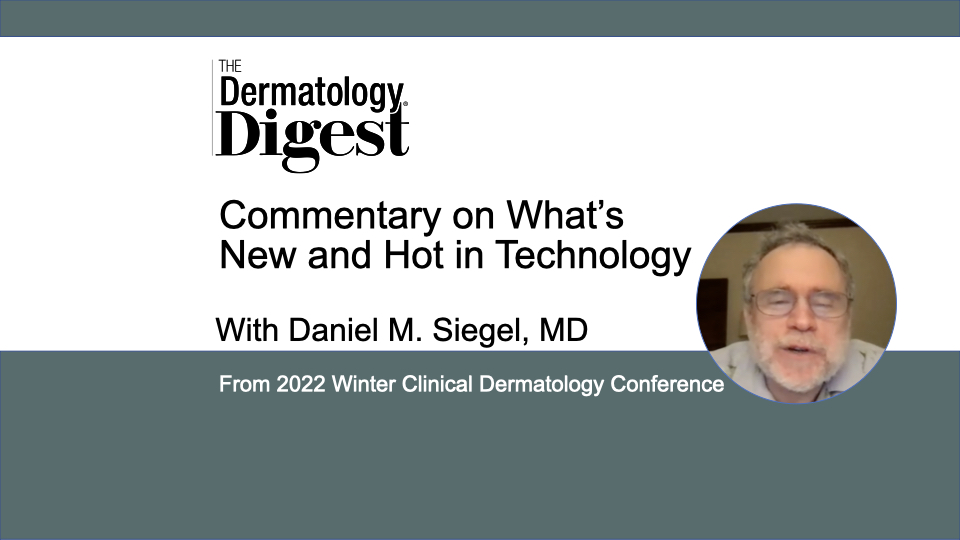Dr. Daniel Siegel discusses technology in the dermatology specialty, including legalities and current and near-future innovations.
Daniel M. Siegel, MD, is Clinical Professor of Dermatology, SUNY Downstate, Smithtown, New York.
“When the first digital cameras came out, I remember at a meeting in 1998 or 1999 holding up a Logitech, and I said, based on the improvements from generations 1 and 2, by 2010 nobody’s going to use film anymore. People thought I was crazy,” said Daniel M. Siegel, MD, who presented “What’s New and Hot in Technology” at the 2022 Winter Clinical Dermatology Conference.
“With the advent of… the iPhone in 2007, suddenly you had an easy-to-use way to take images that were high quality, and the quality of those images, when projected, was as good as anything you could do with 35-mm slide in terms of the perception of the viewer.”
Passionate about all things tech, Dr. Siegel said today’s top of the line phones for taking quality images are the iPhone 13, the Pro, the Pro Max, and the Samsung Galaxy S21 Ultra.
Superior phone cameras and ease of use can also get you into trouble, cautioned Dr. Siegel. HIPAA can become an issue.
“Residents tend to use their cell phone. And when you are using your cell phone for taking pictures of patients, if you lose your cell phone… you could lose your job.”
When using a camera phone for patient photos, Dr. Seigel advises two methods of security: using a failsafe phone login and/or a HIPAA compliant app.
“Instead of having the [standard] four-digit passcode, you can have a complex phrase that could [for example] be your childhood nickname and the name of your best friend and you substitute 1s for Ls.”
Dr. Siegel uses an online password manager only accessible with a creative and complex password that would be meaningless to anyone else.
In terms of HIPAA compliant apps, PicSafe, a cross platform photo vault, allows physicians to remain HIPAA compliant and is made in America. Dr. Siegel believes PicSafe may minimize backdoor access risk.
“But most importantly… you need to make sure that even if you found an app that is HIPAA compliant… you still need to check with your institutional compliance officer, or HIPAA office.”
Nanotechnology
The CDC defines nanotechnology as “the manipulation of matter on a near-atomic scale to produce new structures, materials, and devices.”
Both the Pfizer and Moderna vaccines depend on nanotechnology, making this “the biggest nanotech topic in the past 18 months,” said Dr. Siegel.
Specific to the dermatology specialty, Greenway Therapeutix has nanotechnology in development designed to deliver cannabinoids for the treatment of inflammation, said Dr. Siegel, who is the company’s Chief Scientific Officer.
“Most cannabinoids are sticky… so if you can entrap CBD inside a short-term lipid envelope at 50 nm, that can slip right down hair follicles and appendages and penetrate really well.”
AI Technology
Once referred to as “artificial intelligence,” today AI is more accurately known as “augmented intelligence,” said Dr. Siegel.
“The AI that we’re looking at, for the most part, is primitive. It’s all primitive. It’s machine learning. In other words, it’s not autonomous thought.”
The benefit to humankind, he said, is that machines can do some things more efficiently and accurately than we can.
“For instance, they can take larger amounts of data and find inter-relationships much better than the average person can.”
SkinVision, DermTech, and MetaOptima are among those companies that have AI technology with machine learning algorithms for stratifying malignancy risk in pigmented lesions, said Dr. Siegel. These devices function as early screening tools, which offer benefit to both the dermatologist and patient in terms of time and treatment.
“I’d rather have someone come in who has a defined problem and then I can make the final judgment to whether it needs [treatment] or not.”
In another AI application, Brian Kim, MD, and Dina Katabi, PhD, have designed a technology to examine chronic itch and the effectiveness of itch therapies in children. The technology is a wearable system that tracks motion and breathing at night.
“There’s no video to relay. It just pairs wireless tech and machine learning and [researchers] will be able to quantify and see what’s working. Great for studies. Great for parents. I think there’s a lot of potential opportunity there.”
Electrical Technology
Electrical technology is another option in the dermatologist’s skin cancer detection toolbox.
Electrical Impedance Spectroscopy (EIS) technology (Nevisense; Scibase) is commercially available and uses electrical measurements in the skin for non-visual malignant melanoma detection.
According to the company’s website, “EIS is sensitive to changes in cellular structure, cellular orientation, cell sizes and cell types – all of which are similar to those on which a histopathologist would base his or her diagnosis.”
Another electrical technology (NovaScan) is currently under investigation for differentiating between benign and malignant cells with Cole Relaxation Frequency, said Dr. Siegel.
“If you send an electric current through a cell, the cell contracts, and then it starts to relax. Malignant cells and benign cells and every tissue studied so far—breast, skin, gut, lungs—the graphs [don’t have bimodal distribution] overlap…. It’s amazingly sensitive—amazingly specific. And this will probably wind up on the market for the next year or two.”
Of all the technologies Dr. Siegel has presented on over the years, each shares a common purpose.
“I like to give talks that basically help you look forward…. I try to open people’s eyes to what could be because you just never know which technology you may look at and find another use [for]. You may have that a-ha moment, and it’s fascinating.”

